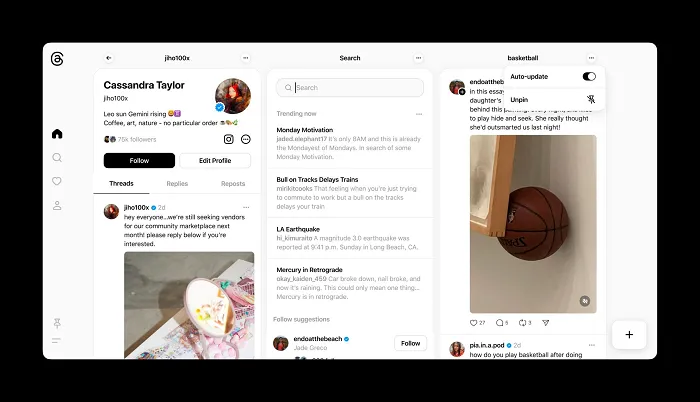Threads’ TweetDeck-Like Desktop Display is Coming to All Users

After testing out its new Tweetdeck-style UI for Threads on desktop over the past few weeks, Meta has now announced that it’s rolling out the new threads.net on desktop globally, providing more customization and monitoring options for Threads users.

As you can see in this preview image, posted by Instagram chief Adam Mosseri, the new Threads desktop UI enables you to create custom streams of Threads updates, on whatever topics you choose, which can then be displayed in a single workspace, alongside your “Following” and “For you” feeds.
With the new UI, you can add dedicated columns for your favorite searches, tags, and accounts, as well as your saved posts, and notifications.
You can even turn on “Auto-update” on any column, which will then see new content appear in real time (you can see this in the third column in the preview image above).
The Threads team is also working on an update that will enable you to easily drag and drop your columns in the display to update their placement.
It’s a good update, which will add to the utility of Threads as a news gathering and monitoring tool, while brand managers will also now able to keep tabs on relevant discussions in the app, in addition to tracking key profiles of interest.
It could also make Threads more valuable for real-time news engagement.
Similar to Twitter, which Threads is modeled on, a key strength of the app is real time discussion, and enabling users to keep up to date with topics of interest. Thus far, however, the Threads team has been somewhat resistant to real-time feeds, due to concerns that they could end up filled with spammers, while also facilitating the spread of misinformation and angst.
But it is coming around, both with this new Threads desktop UI, and the addition of a “Recent” sorting option in search results earlier this month.
Essentially, while Meta wants to take a different approach with Threads than the path that saw Twitter become a hive of spam and division, real-time, topical discussion is critical, so it needs to better facilitate such in order to capitalize on its opportunity.
Which Threads is seemingly now realizing, with Mosseri also further clarifying his anti-news stance in the app earlier this week:
Mosseri has also explained that its efforts to limit the spread of political content “work primarily at the account level, not the post level,” which is an important distinction as well.
That effectively means that users who post about politics every now and then will not be impacted by any reach penalty as a result of such, but profiles that constantly share and re-share political posts will see less reach.
But not necessarily less engagement.
Again, from Mosseri:
“We’re not anti-news, we’re just not looking to amplify political news. If you follow lots of political accounts, the ranking of posts from those accounts won’t be effected by any of this.”
So while the Threads algorithm will actively reduce the reach of accounts that always post about politics, which are often engagement-baiting influencers seeking to trigger comments and discussion, individual political posts won’t be impacted, nor will it stop posts from profiles that you’ve chosen to follow appearing in your “For You” feed.
It’s a difficult balance for Mosseri to explain, and he has put himself in a difficult position by trying to be more transparent, because if he reveals all of the measures that they have in place to limit the reach of political content, engagement-baiters will use that as a playbook for their strategic approach.
But basically, Threads is looking to limit broader political discussion, by reducing the reach of accounts that primarily post about politics, as a disincentive for such. But posting about politics every now and then is fine.
It’ll be interesting to see what impact that has in practice, but it does seem that, over time, Threads is slowly establishing its place in the broader social media landscape, with tools like this adding to its utility.




